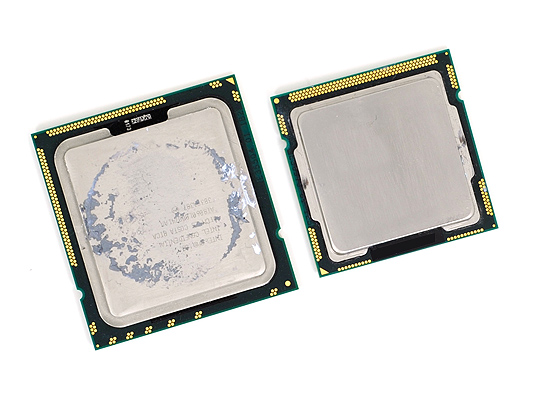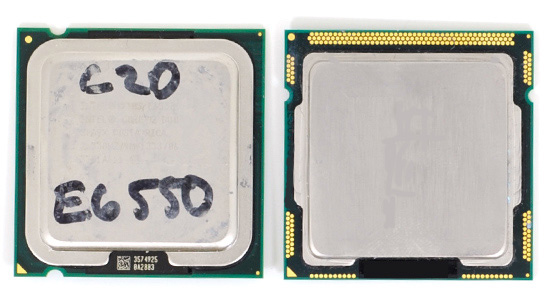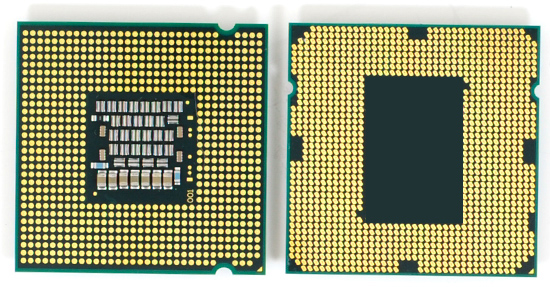The Lynnfield Preview: Rumblings of Revenge
by Anand Lal Shimpi on May 29, 2009 1:00 PM EST- Posted in
- CPUs
The First Lynnfield Sample
Let me preface this with the usual disclaimer. Intel did *not* supply me with this chip and it is most definitely pre-production silicon, not necessarily indicative of final, shipping performance.
With that out of the way, here is Lynnfield:

Lynnfield (front) vs. Bloomfield (back)

Core i7-Bloomfield (left) vs. Lynnfield (right)
It’s a lot smaller than the LGA-1366 Core i7, but compared to current Core 2 Quads it’s actually similar in size:

LGA-775 Core 2 Duo (left) vs. LGA-1156 Lynnfield (right)
Flipping the chips over you see that Lynnfield has a much higher pad density, enabling Intel to fit 1156 pads in about the same space as it fit 775 pads just a few years prior.

Core 2 (left) vs. Lynnfield (right)
Once more, I’ve blanked out all of the caps and other markings on the chip to protect the innocent.
The initial Lynnfield samples were all clocked at 2.13GHz with HT enabled. Turbo mode was also enabled but it too was a meager 2.26GHz regardless of how many cores were active. All of this was to enable motherboard manufacturers to test compatibility and performance of their P55 without giving away Lynnfield’s true performance.
Unfortunately this is the sample I tested with. Thankfully it was healthy enough for me to overclock the BLCK to 166MHz, resulting in a 2.66GHz frequency. Turbo mode was still stuck at a 1x increase over the stock frequency, so final Lynnfield performance should be much better in single and dual threaded apps than what you’ll see here today.
The results on the coming pages show three configurations. Lynnfield running at 2.13GHz with HT enabled, 2.66GHz with HT enabled and 2.66GHz with HT disabled. The latter is going to be the closest to actual Lynnfield performance (albeit still far away thanks the sample’s crippled turbo mode), the 2.66GHz with HT enabled just shows how much we gain from HT and the 2.13GHz chip is an experiment in seeing how low Intel could drop these things and still have a competitive part.
If you thought Nehalem needed Hyper Threading to be a strong performer, you were dead wrong.
Comments About Lynnfield's Readiness
The current rumors in the press are that Lynnfield is being held back in order to clear out excess Core 2 Quad inventory before it ships, because once this thing ships no one is going to want a Penryn anymore. Based on what I've seen, Lynnfield isn't ready just yet - it's not an artificial delay.
The motherboards are in rough shape, CF/SLI isn't working and we're still at very early revs of the CPU's silicon. While I think that the chip will be ready far in advance of its rumored September shipdate, the CPU and motherboards aren't yet.
The Test
Once more: the CPU we've tested here is pre-production silicon without all of its turbo modes enabled. I expect final, shipping performance to be higher in some cases.
| Motherboard: | Pre-release P55 Motherboard (Intel P55) Intel DX58SO (Intel X58) Gigabyte GA-MA790FX-UD5P (AMD 790FX) |
| Chipset: | Intel P55 |
| Chipset Drivers: | Intel 9.1.1.1012 (Intel) AMD Catalyst 8.12 |
| Hard Disk: | Intel X25-M SSD (80GB) |
| Memory: | Qimonda DDR3-1066 4 x 1GB (7-7-7-20) Corsair DDR3-1333 2 x 2GB (7-7-7-20) |
| Video Card: | eVGA GeForce GTX 280 |
| Video Drivers: | NVIDIA ForceWare 180.43 (Vista64) NVIDIA ForceWare 178.24 (Vista32) |
| Desktop Resolution: | 1920 x 1200 |
| OS: | Windows Vista Ultimate 32-bit (for SYSMark) Windows Vista Ultimate 64-bit |










95 Comments
View All Comments
Jabbernyx - Monday, June 1, 2009 - link
You're forgetting the $10 off promo code and 5% Live cashback ;)Randomblame - Friday, May 29, 2009 - link
Anyone else irritated that when this launches intel will have 5 sockets going?Shall we count em?
lga 775 core 2
lga 1366 i7
lga 1160 lynfield
lga 771 xeon penryn
lga 611 itanium
Did I miss any?
Anonymous Freak - Sunday, May 31, 2009 - link
If you're going to include Itanium; you might as well include the mobile sockets as well.Last October, Intel had one desktop, three server, and two mobile sockets:
LGA775 on the desktop was it.
LGA771 for dual Xeon, PGA-604 for quad-plus Xeon. (And LGA775 for single-socket servers, where the processors were just Core 2 series processors slapped with a "Xeon" name on them, so I'm keeping that with 'desktop'.) PAC-611 is Itanium.
Socket M is the slightly older mobile socket, Socket P is the newer. One could say that Socket M was already dead in October.
Early next year, we will have three desktop, two server, and two mobile sockets.
LGA 775 will be the low-end Core 2 socket, LGA 1366 for i7, and LGA 1156 for Lynnfield. Lynnfield should overtake Core 2 very quickly, especially after the integrated-graphics chips come out, and drop to two desktop sockets, though.
LGA 1366 doubles as the single and dual server socket; and the new "Nehalem EX" will in all likelihood have a new socket shared with the new Itanium (from reasonable guesses, anyway.)
Mobile will have just Socket P until the mobile Nehalems launch, when a new mobile Nehalem socket will be out.
Sorry, but LGA 771 is already dead. Its processors are completely obsolete at this point, by Nehalem-EP. And PGA-604 (which you missed,) as well as PAC-611, will be obsoleted by the Nehalem-EX socket. (Again, just guessing. The entire point of QPI was to make Xeon and Itanium share resources, so I would imagine they would use the same socket. Especially with Xeons now at higher power draw than even the highest draw Itanium; there is no reason for Itanium's goofy socket-with-power-pod arrangement any more.
Drazick - Friday, May 29, 2009 - link
Though the system looks good.I really liked the one chip Idea (Chipset).
I hope Intel eventually let nVidia develop chipsets for this platform.
Why don't you think the regular PCIE X16 lane in this system is enough for GPGPU? It might not be the best but for Encoding some movies and Accelerating Matlab it should be enough, no?
Anand Lal Shimpi - Saturday, May 30, 2009 - link
I didn't mean to imply that 16 PCIe 2.0 lanes aren't enough for GPGPU. But if you're doing a *lot* of compute over the PCIe bus, perhaps over multiple very high end GPUs, then you'll probably want QPI. This is more of a HPC or head-in-the-clouds-desktop scenario though.It should be more than enough for GPU based video encode or math.
Take care,
Anand
ssj4Gogeta - Friday, May 29, 2009 - link
Even if Intel allows Nvidia, they can't make integrated graphics for i5 because the chip is connected to the chipset via 2 GB/s DMI, which will bottleneck it.Doormat - Friday, May 29, 2009 - link
Until the price of 4GB DDR3 sticks come down (and I could put 16GB of RAM on the board), I think the i7 is where its at. At least with i7, I can go with 12GB now and then upgrade to 24GB later (12GB I need, 24GB I don't know...).A5 - Friday, May 29, 2009 - link
If you NEED 12GB, then Lynnfield isn't going to be for you. Intel would much rather you use Xeons for that kind of workload anyway :Pltcommanderdata - Friday, May 29, 2009 - link
So with mainstream Nehalems not having any QPI links and high-end Nehalems with QPI not needing them, are third-party IGPs dead? It seems that even if nVidia can win their legal issues with Intel, the technical challenges of being limited to DMI seem to make the Intel chipset business unprofitable. Higher priced chipsets with IGPs would be bandwidth limited over DMI and just making southbridges doesn't seem very glamourous or profitable.Anand Lal Shimpi - Saturday, May 30, 2009 - link
NVIDIA claims to have DMI based IGPs in development for LGA-1156 platforms. We'll see how good they are and if they do end up coming to market despite the legal issues.In the long run I don't expect the 3rd party chipset business to survive on either platform (AMD or Intel). Unless either company is horribly deficient at some basic platform need I'd expect desktop and mobile AMD CPUs to use AMD chipsets and for desktop and mobile Intel CPUs to use Intel chipsets. It may take a couple of years to get there but I think the end result is inevitable.
I believe that's why we're seeing such a strong push from NVIDIA lately with things like Ion. Attempting to stay put when we know what the tide is about to do is a difficult task.
Take care,
Anand